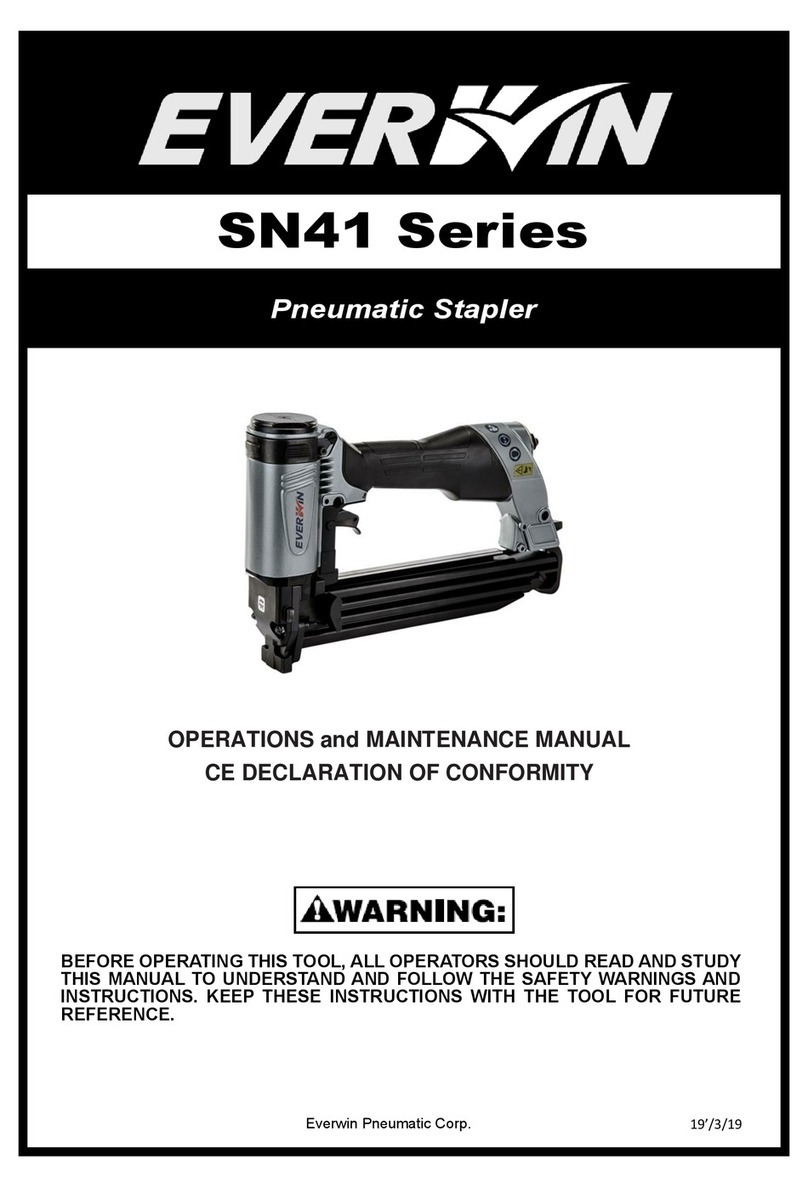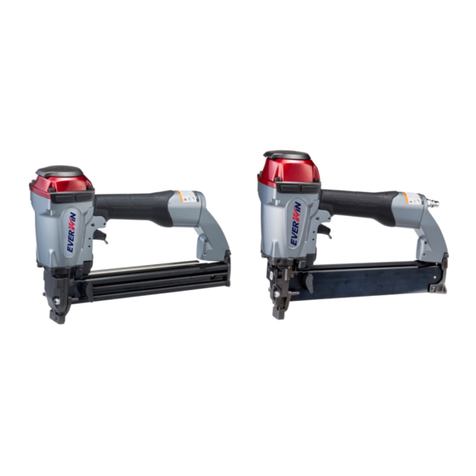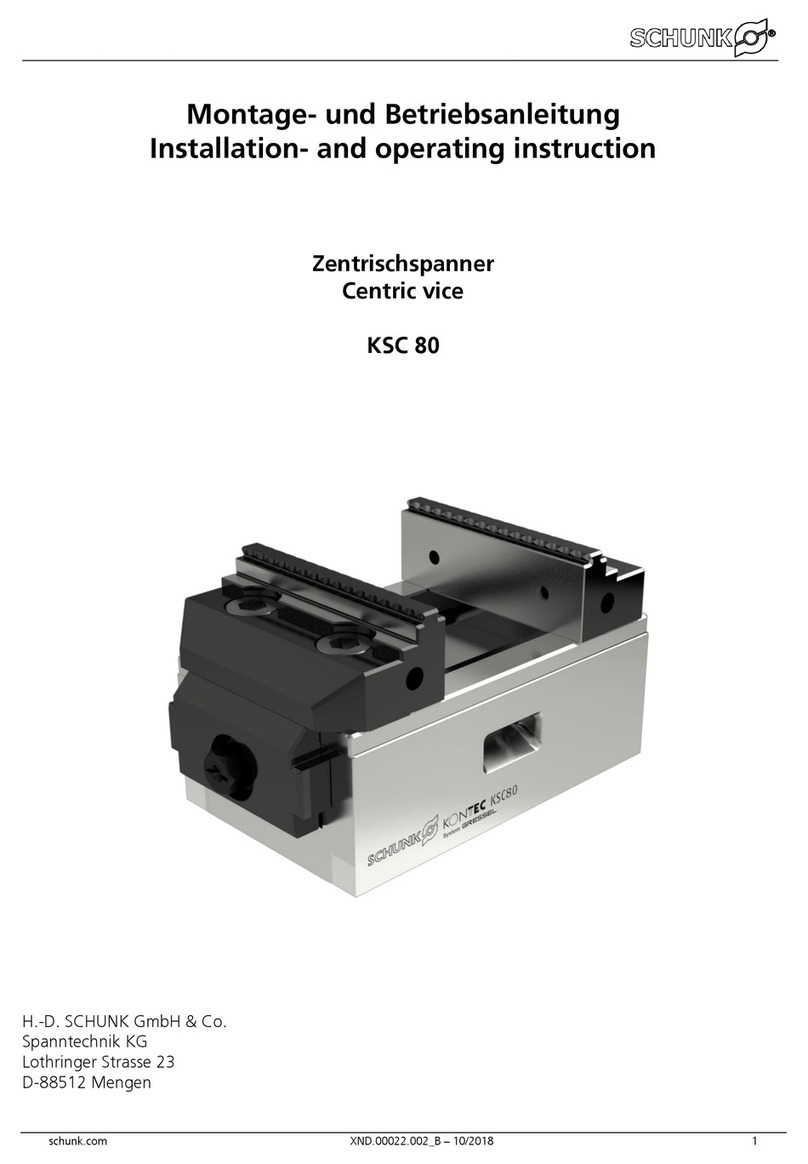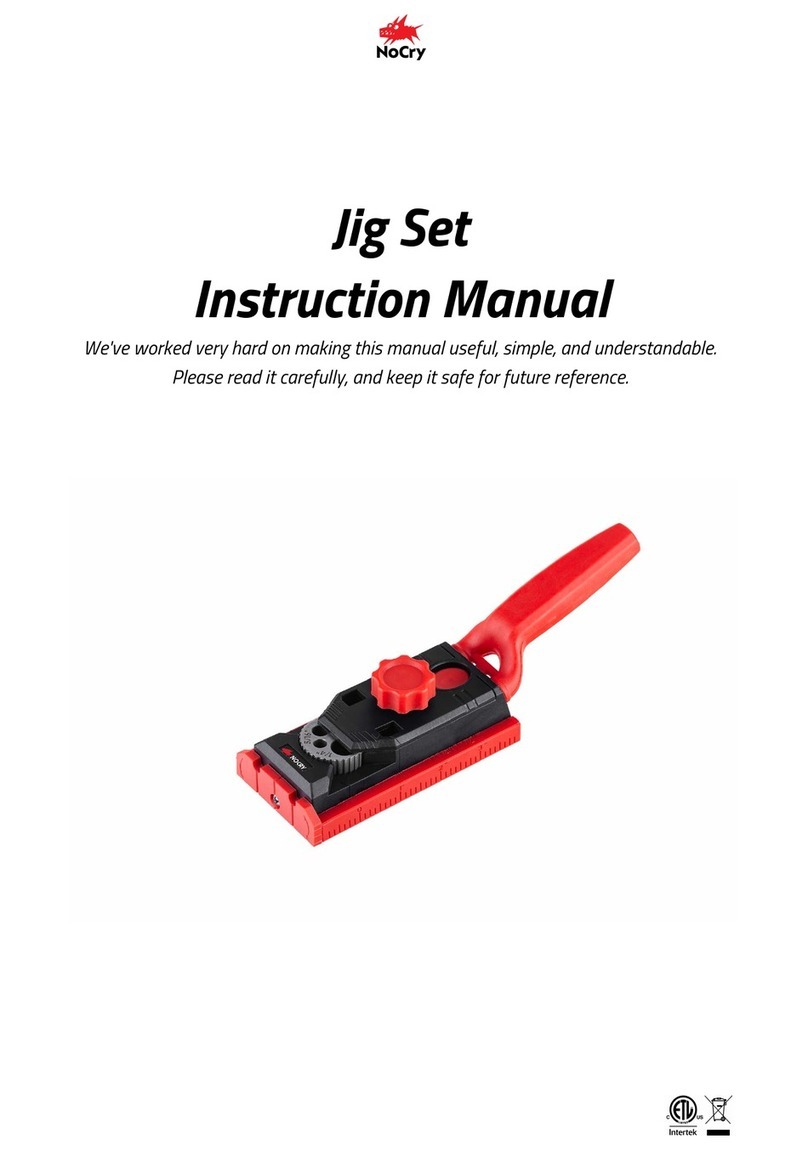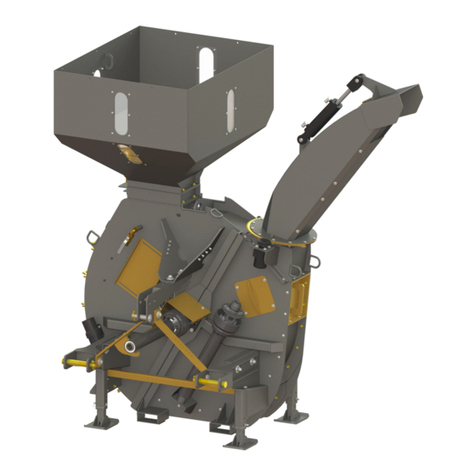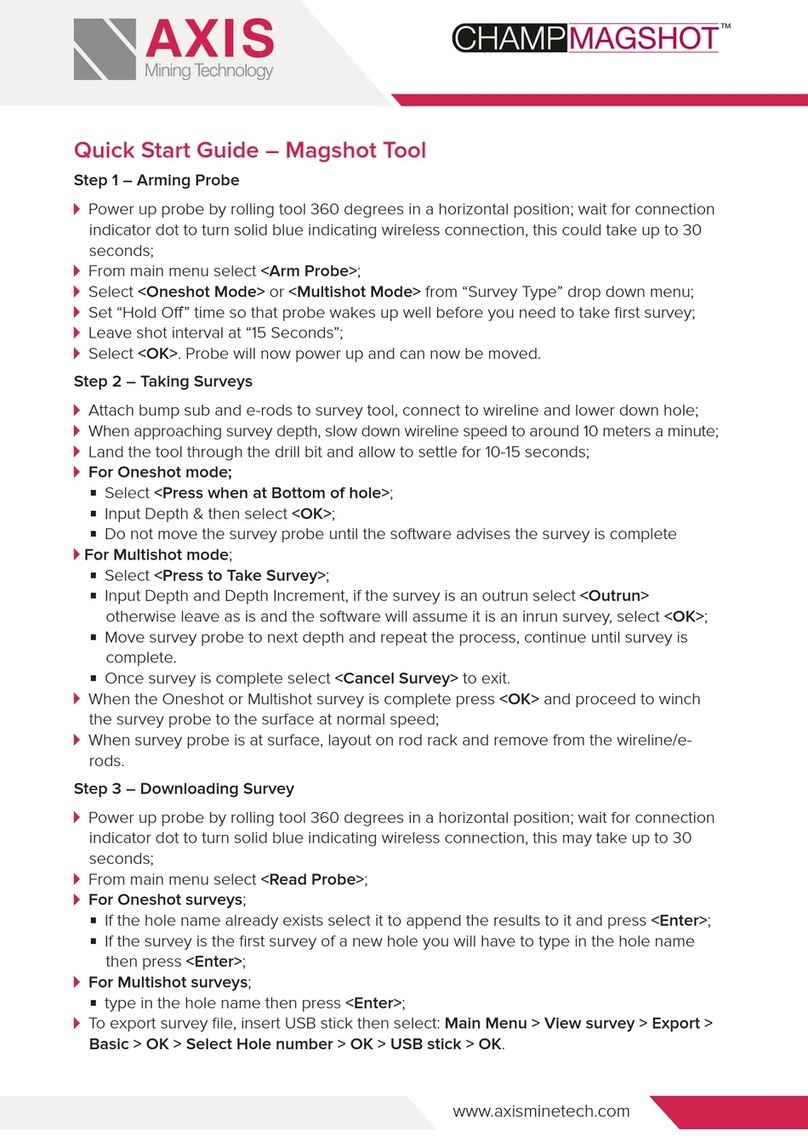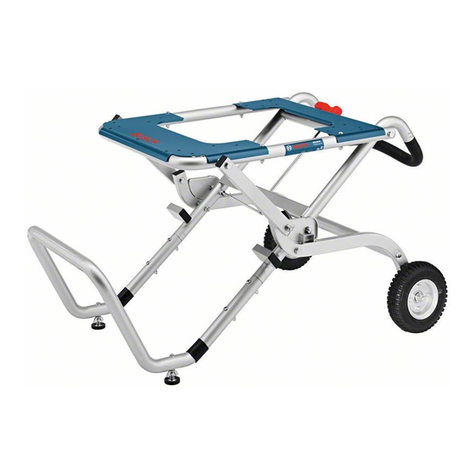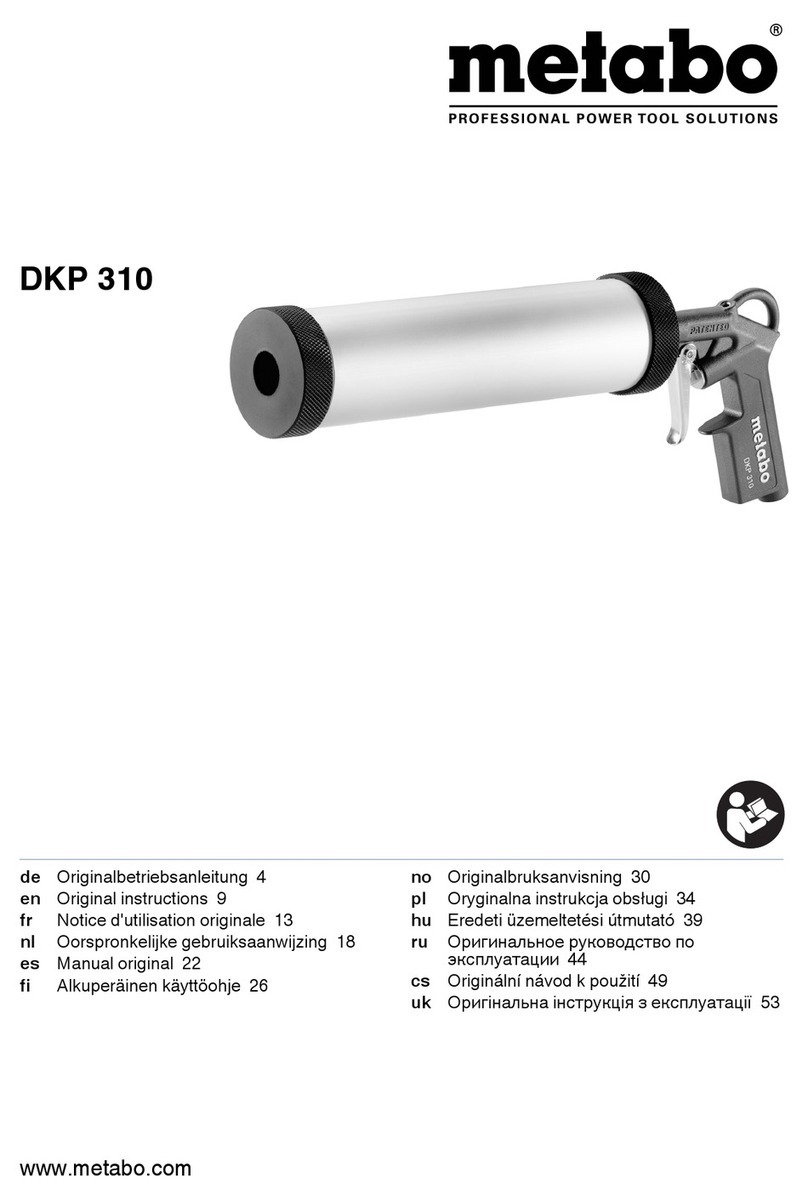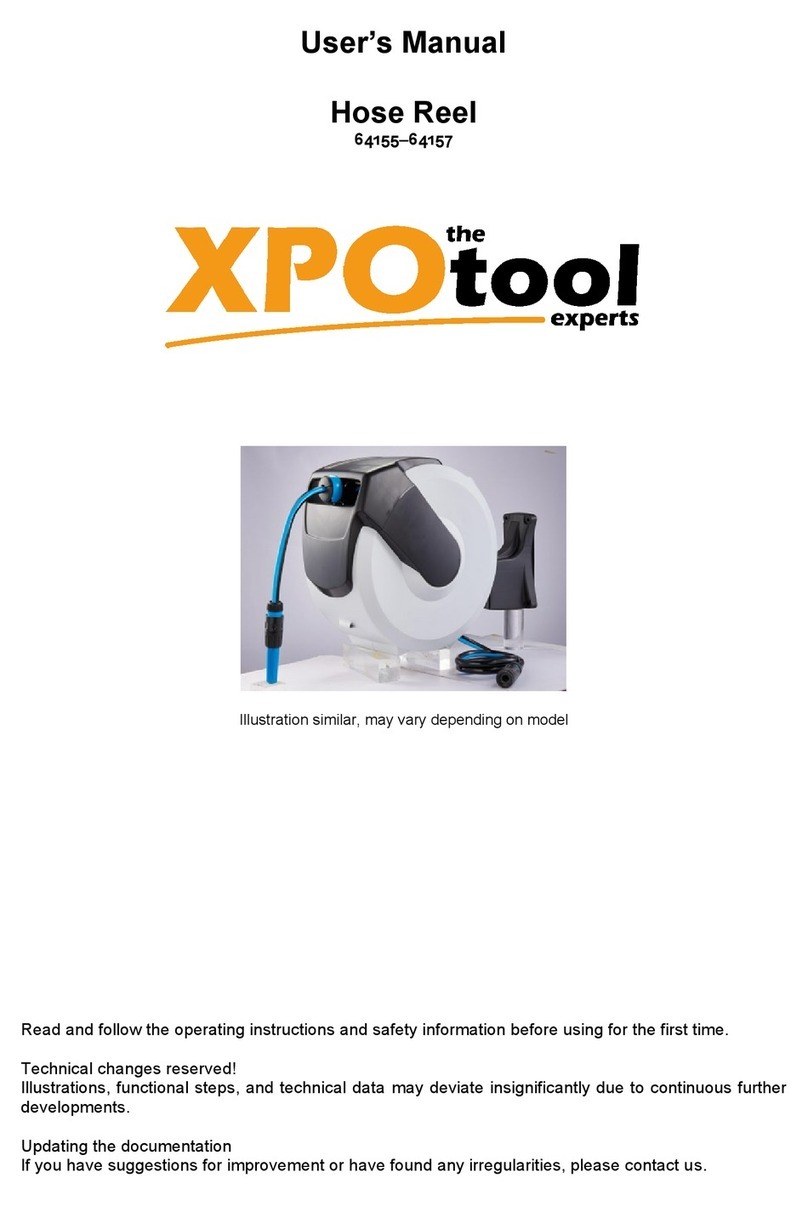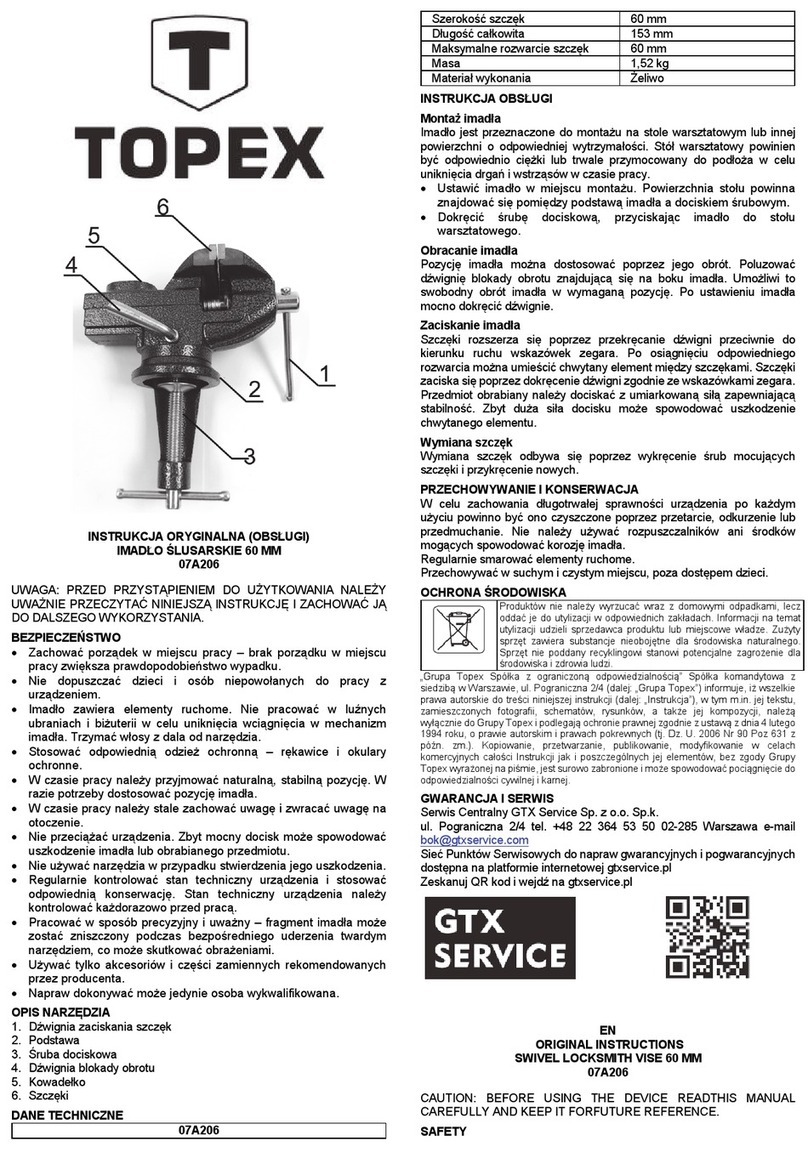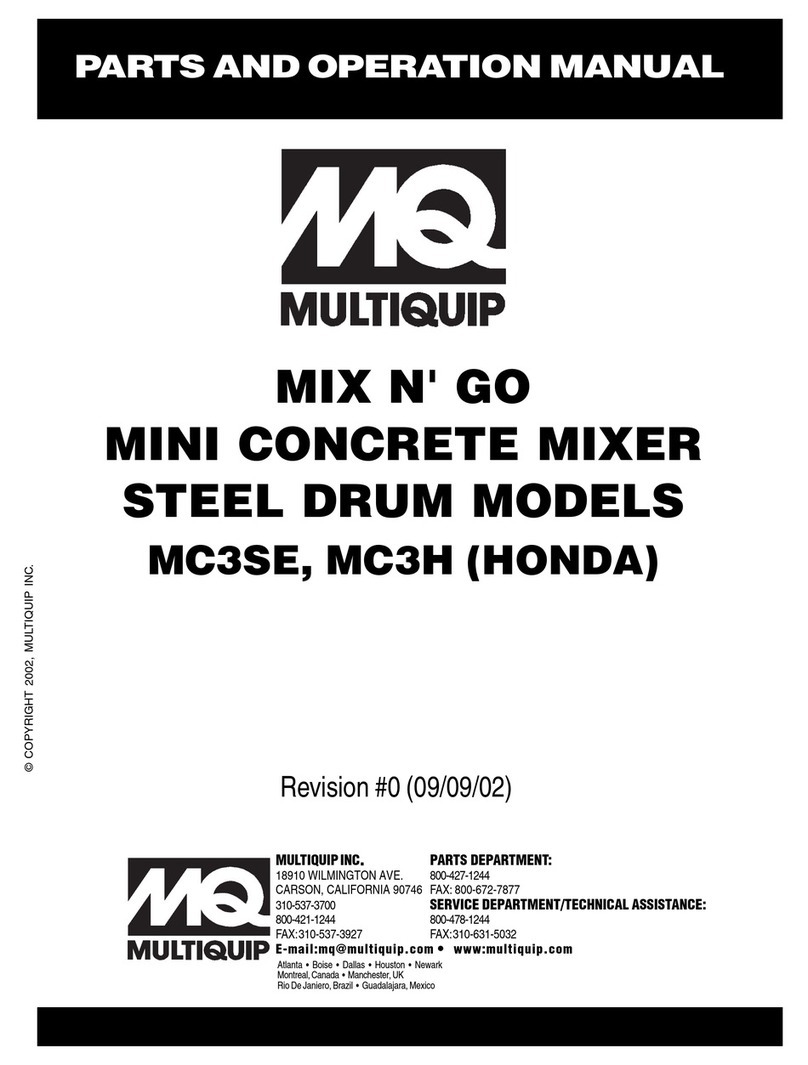Everwin SN65Q User manual

Pneumatic Stapler
OPERATIONS and MAINTENANCE MANUAL
SN65Q / SN65S5
BEFORE OPERATING THIS TOOL, ALL OPERATORS SHOULD READ AND
STUDY THIS MANUAL TO UNDERSTAND AND FOLLOW THE SAFETY
WARNINGS AND INSTRUCTIONS. KEEP THESE INSTRUCTIONS WITH THE
TOOL FOR FUTURE REFERENCE.
REV September, 23, 2022
106337
WARNING:
!
TOUGHER FASTER SMARTER

1-YEAR LIMITED WARRANTY
CE DECLARATION OF CONFORMITY
SAFETY INSTRUCTIONS
GENERAL SAFETY INSTRUCTION
SPECIFICATIONS AND TECHNICAL DATA
OPERATION : TRIGGER SELECTION
OPERATION : AIR SUPPLY AND CONNECTIONS
(ttings, hoses, lters, air consumption, regulators, supply source)
OPERATION : LUBRICATION
OPERATION : FASTENER LOADING
OPERATION : TOOL OPERATION SYSTEM
OPERATION : TOOL OPERATION CHECK
OPERATION : TOOL-SPECIFIC FEATURES
MAINTAINING THE PNEUMATIC TOOL
TROUBLE SHOOTING / REPAIRS
3
4
5
7
9
11
12
13
14
15
16
17
18
19
The tool is designed for high-speed and high-volume fastening. This tool delivers efficient and dependable service
when used correctly with care. As with any fine power tool, the manufacturer’s instructions must be followed for best
performance.
Please study this manual before operating the tool and understand the safety warnings and cautions. The instructions on
installation, operation, and maintenance should be read carefully, and the manuals kept available for reference.
Additional safety measures may be required because of your particular application of the tool. Contact your EVERWIN
representative or distributor with any questions concerning the tool and its use.
Everwin Pneumatic Corp.,
No.7, Wugong 7th Road, Wufeng District, Taichung City, 413, Taiwan
NOTE
INDEX
INTRODUCTION
2

1-YEAR LIMITED WARRANTY
(U.S. and Canada Only)
GROUNDS FOR INDUSTRIAL / PRODUCTION TOOL COVERAGE
WARRANTY EXCLUSIONS
EVERWIN products are designed and manufactured to the highest standards of both material and workmanship. EVERWIN
warrants responsibility to the original retail purchaser that the product purchased was free from defect in material and
workmanship, and agrees to repair or replace at EVERWIN‘s option any defective EVERWIN pneumatic stapler or
nailer for a period of one year, subject to the exclusions and limitations described hereunder. To honor a warranty claim,
EVERWIN and its authorized distributors need proof of purchase, may request the damaged tool, the serial number of the
damaged tool, photos/videos of the defect for test and evaluation to determine whether the damaged tool is within warranty
conditions; purchasers’ cooperation in this regard will expedite the claim process and help EVERWIN’s continuous efforts
in quality improvement.
THIS WARRANTY IS IN LIEU OF ALL OTHER WARRANTIES, EXPRESS OR IMPLIED, INCLUDING BUT NOT LIMITED
TO THE IMPLIED WARRANTIES OF MERCHANTABILITY OR FITNESS FOR A PARTICULAR PURPOSE. EVERWIN
SHALL NOT BE LIABLE FOR ANY INCIDENTAL OR CONSEQUENTIAL DAMAGES.
For high production industrial tools, coverage is limited to 90 days due to high volume usage; warranty on production tools
cannot be guaranteed due to unpredictable circumstances. Tools are subjected to abuse such as hammering or usage of
adjustment tools, especially true in loan tool programs. Upon receiving a report, EVERWIN and its authorized distributor
may request the damaged tool, serial number of the damaged tool (as a gauge for the tool’s age), and photos/videos of the
defect for test and evaluation to find root causes. EVERWIN’s analyst will judge the issuance of defective parts and will.
The following warranty exclusions apply :
Normal wear parts are not covered by this warranty. Examples of normal wear parts include; O-rings and seals, driver
blades, bumpers, pistons and piston rings.
Failure due to normal wear, neglect, abuse, misuse, misapplication, accidents, over-pressure usage, improper storage,
shipping damages, improper maintenance, operation not within the operation manual’s specification etc. are not
covered by this warranty.
Labor charges, loss, repairs from improper maintenance and/or usage of non-EVERWIN parts are not covered by this
warranty.
This warranty does not apply to production or industrial tools as defined by EVERWIN; industrial or production tools are
covered on the following grounds.
NOTE
All warranty services will be carried out by EVERWIN authorized repair centers, please contact:
[email protected] for the location most convenient for you.
3

Machine Type : SN65Q, SN65S5
Machine Name : Pneumatic Fastener Driving Tool
Place of Issue : No. 7, Wugong 7th Rd., Wufeng Dist., Taichung City 41353, Taiwan.
Date of Issue :September, 23, 2022
Signature of Issuer :_______________________
Hung-Ming Chuang
General Manager
CE Declaration of conformity
EVERWIN PNEUMATIC CORP. declares that the product as described in attached documentation is in conformity with the
Machinery Directive 2006/42/EC and the European standard EN ISO 11148-13:2018.
CE konformiteitsverklaring
EVERWIN PNEUMATIC CORP. verklaart hierbij onder eigen verant woordelijkheid dat deze machine in overeenstemming is met
de Europese Richtlijnen 2006/42/EC en de Europese norm EN ISO 11148-13:2018.
CE Konformitätserklärung
EVERWIN PNEUMATIC CORP. erklärt hiermit in alleiniger Verantwortung das dieses Gerät ubereinstimmt mit den Europäischen
Richtlinien 2006/42/EC undden Europäischen Norm EN ISO 11148-13:2018.
Overensstemmelseserklæring / CE Deklaration
EVERWIN PNEUMATIC CORP. erklærer herved, at produktet er i overenstemmelse med nedenstående normer eller normative
dokumenter 2006/42/EC i henhold til bestemmelserne i EU’s direktiv EN ISO 11148-13:2018.
Todistus CE standardinmukaisuudesta
EVERWIN PNEUMATIC CORP. vakuuttaa täten tuotteen vastaavan seuraavla standardeja ja direktiivejä: 2006/42/EC ja EN ISO
11148-13:2018.
CE Dichiarazione di conformità
EVERWIN PNEUMATIC CORP. dichiara, assumendo la piena responsabilità, che questa fissatrice e conforme alla Direttive
Europee 2006/42/EC e alla norma armonizzata EN ISO 11148-13:2018.
CE Declaracion de conformidad
EVERWIN PNEUMATIC CORP. declaramos bajo nuestra sola responsabilidad que este producto esta enconformidad con las
Directivas Europeas 2006/42/EC y con la normativa EN ISO 11148-13:2018.
SAMSVARSERKLÆRING / CE Deklaration
EVERWIN PNEUMATIC CORP. erklærer herved att produktet er i samsvar med følgende normer og direktiv 2006/42 EC og NS-
EN ISO 11148-13:2018.
CE Déclaration de conformité
EVERWIN PNEUMATIC CORP. déclare et prend sur soi toute la responsabilité de cette déclaration, que le produit esten
conformité avec les Directives Européennes 2006/42/EC et avec la norme harmonisée EN ISO 11148-13:2018.
Överstämmelseförklaring / CE Deklaration
EVERWIN PNEUMATIC CORP. förklarar härmed att produkten överensstämmer med följande normer och direktiv 2006/42/EC
och SS-EN ISO 11148-13:2018.
Deklaracja zgodności CE
EVERWIN PNEUMATIC CORP. oświadcza, że produkty opisane w załączonej dokumentacji spełniają wymogi Dyrektywy
Maszynowej 2006/42/EC oraz Europejskiej normy EN ISO 11148-13:2018.
ENGLISH
NEDERLANDS
DEUTSCH
DANSK
FINSK
ITALIANO
ESPAGNOL
NORSK
FRANCAIS
SVENSK
POLSKIE
CE DECLARATION OF CONFORMITY
4

NOTE
TO AVOID SEVERE PERSONAL INJURY OR PROPERTY DAMAGE
Before operating this tool, all operators should read and study this manual to understand and follow the
safety warnings and instructions. Failure to follow warnings could result in death or serious injury. Keep
these instructions with the tool for future reference.
Eye Protection
Which conforms to ANSI/ CE specifications and provides protection against flying particles both from
the FRONT and SIDE should ALWAYS be worn by the operator and others in the work area when
connecting to air supply, loading, operating, or servicing this tool. Eye protection is required to guard
against flying fasteners and debris, which could cause severe eye injury. The employer and/or user must
ensure that proper eye protection is worn. Eye protection equipment must conform to the requirements
of the ANSI Z87.1 and 89/686/EEC, and provide both frontal and side protection.
CAUTION
Additional Safety Protection is required in some environments. For example, the working area may
include exposure to noise level which can lead to hearing damage. The employer and user must ensure
that any necessary hearing protection is provided and used by the operator and others in the work area.
Some environments will require the use of head protection equipment. When required, the employer and
user must ensure that head protection conforming to ANSI Z89.1/ CE is used.
AIR SUPPLY AND CONNECTIONS
Do not use oxygen, combustible gases, or bottled gases as a power source for this tool as tool may
explode possibly causing injury.
Do not use supply sources which can potentially exceed 14bar (200 PSI) as the tool may burst, possibly
causing injury.
The connector on the tool must not hold pressure when air supply is disconnected. If a wrong fitting is
used, the tool can remain charged with air after disconnecting and thus will be able to drive a fastener
even after the air line is disconnected, possibly causing injury. Do not pull trigger or depress contact arm
while connected to the air supply as the tool may cycle, possibly causing injury.
Always disconnect air supply: 1.) Before making adjustments; 2.) When servicing the tool; 3.) When
clearing a jam; 4.) When tool is not in use; 5.) When moving to a different work area; otherwise,
accidental actuation may occur, possibly causing injury.
Non-side shielded spectacles and face shields alone do not provide adequate protection.
SAFETY INSTRUCTIONS
C2H2
O2
5

FASTENER LOADING
When loading the tool: 1.) Never place a hand or any part of body in the fastener discharge area of
the tool; 2.) Never point the tool at anyone; 3.) Do not pull the trigger or depress the trip as accidental
actuation may occur, causing injury.
OPERATION
Always handle the tool with care: 1.) Never engage in horseplay; 2.) Only pull the trigger when the nose
is directed toward the work piece; 3.) Keep a safe distance from other while the tool while tool is in
operation as accidental actuation may occur, causing injury.
The operator must not hold the trigger or press on contact arm except during fastening operation as
serious injury can result if the trip accidentally contacts someone or something, causing the tool to
cycle.
Keep hands and body away from the discharge area of the tool. A contact arm tool may bounce from the
recoil of driving a fastener and an unwanted second fastener may be driven, possibly causing injury.
Check operation of the contact-arm mechanism frequently. Do not use the tool if the arm is not working
correctly as accidental driving of a fastener may result. Do not interfere with the proper operation of the
contact-arm mechanism.
Do not drive fasteners on top of other fasteners or with the tool at an overly steep angle as this may
cause deflection of fasteners which could cause injury.
Do not drive fasteners close to the edge of the work piece as the wood may split, allowing the fastener
to be deflected causing injury.
This tool has either a selective actuation for contact actuation or sequential contact actuation, or is
solely contact actuation, or solely contact actuation. Its intended uses are for production applications
such as pallets, furniture, manufactured housing, upholstery, and sheathing.
When using this tool in selective actuation mode, always ensure it is in the correct actuation setting.
Do not use this tool in contact actuation for applications such as closing boxes or crates and fitting
transportation safety systems on trailers and lorries.
Be careful when changing from one driving location to another.
MAINTAINING THE TOOL
When working on air tools, note the warnings in this manual and use extra care when evaluating tools
with problems.
SAFETY INSTRUCTIONS
6

The Directive 2006/42/EC and the regulation 2008
No. 1957 and the ISO International Standard EN
ISO 11148-13:2018 lay down certain safety requirements for hand-
held non-electric power fastener driving tools, and in your own interest we
recommend you follow these safety requirements without exception.
Read and understand tool labels and the manual. Failure to
follow warnings could result in serious injury.
Operators and others in the work area shall wear impact-
resistant eye protection with side shields.
Operators and others in the work area shall wear hearing
protection.
EVERWIN fasteners driving tools consist of: tool and fasteners. In the
interests of operator and system safety, the tool and fasteners referred to
in the EVERWIN documents, must be considered as one single, complete
system.
.EVERWIN fasteners driving tools must be used like described in the
operating manual.
.EVERWIN fasteners driving tools shall only be used for production
applications. For applications outside of production applications, please
consult an authorized EVERWIN distributor for proper safety conversion
kits.
.Keep fingers away from trigger when not operating this tool and when
moving from one operating position to another.
.The fastener driving tool shall be disconnected when unloading fasteners,
making adjustments, clearing jams or changing accessories.
.During operation be careful that fasteners penetrate material correctly
and cannot be deected /misred towards operator and /or any bystanders.
.During operation, debris from the workpiece and fastening/collation
system may be discharged.
.Always wear impact-resistant eye protection with side shields during
operation of the tool.
.The risks to others shall be assessed by the operator.
.Be careful with tools without workpiece contact as they can be fired
unintentionally and injure operator and/or bystander.
.Ensure tool is always safely engaged on the workpiece and cannot slip.
.Hold the tool correctly: be ready to counteract normal or sudden
movements such as recoil.
.Maintain a balanced body position and secure footing.
.Appropriate safety glasses shall be used, and appropriate gloves and
protective clothing are recommended.
.Appropriate hearing protection shall be worn.
.Use the correct energy supply as directed in the manual.
.To drive fasteners into hard surfaces like steel & concrete use the
appropriated tools. For users in countries in the EU, please refer to EC
declaration of those tools. For users in the UK, please refer to UKCA
declaration of those tools. For these tools the angle between the tool and
the surface must not be over 15°.
.Read and understand the safety instructions before connecting,
disconnecting, loading, operating, maintaining, changing accessories on, or
working near the tool. Failure to do so can result in serious bodily injury.
.Keep all body parts such as hands and legs, etc., away from firing
direction and ensure fasteners cannot penetrate through a workpiece into
parts of the body.
.When using the tool, be aware that the fastener could deect and cause
injury.
.Hold the tool with a rm grasp and be prepared to manage recoil.
.Only technically skilled operators should use the fastener driving tool.
.Do not modify the fastener driving tool. Modifications may reduce the
effectiveness of safety measures and increase the risks to the operator and/
or bystander.
.Review information for tools intended to be used on hard surfaces
such as steel and concrete regarding the additional downforce required to
operate the tool and prevent slipping.
.Do not discard the safety instructions.
.Do not use a tool if the tool has been damaged.
.Be careful when handling fasteners, especially when loading and
unloading, as the fasteners have sharp points which could cause injury.
.Always check the tool before use for broken, misconnected, or worn
parts.
.Do not overreach. Only use in a safe working place. Keep proper footing
and balance at all times.
.Keep bystanders away (when working in an area where there is a
likelihood of through trafc of people). Clearly mark off your operating area.
.Never point the tool at yourself or others. If the operator has to move
locations, the tool must be carried pointed downwards.
.Only wear gloves that provide adequate feel and safe control of triggers
and any adjusting devices.
GENERAL SAFETY INSTRUCTION
EVERWIN Fastener Driving Tools
Statement of Use
Projectile Hazards
Operating Hazards
General Safety Rules
Multiple Hazards
7

.The vibration emission value reported in the operation manual is a tool-
related characteristic value and does not represent the influence to the
hand-arm-system when using the tool. Any inuence to the
hand-arm-system when using the tool will for example depend on the
gripping force, the contact pressure force, the working direction, the
adjustment of energy supply, the workpiece, the workpiece support.
.Exposure to vibration can cause disabling damage to the nerves and
blood supply of the hands and arms.
.Wear warm clothing when working in cold conditions, keep your hands
warm and dry.
.If you experience numbness, tingling, pain, or whitening of the skin in
your fingers or hands, seek medical advice from a qualified occupational
health professional regarding overall activities.
.Operate and maintain the tool as recommended in these instructions, to
prevent an unnecessary increase in vibration levels.
.Hold the tool with a light, but safe, grip because the risk from vibration is
generally greater when the grip force is higher.
.Compressed air can cause severe injury.
.Always shut off air supply and disconnect tool from air supply when not in
use.
.Always disconnect the tool from the compressed air supply before
changing accessories, making adjustments and /or repairs, when moving
away from an operating area to a different area.
.Keep fingers away from trigger when not operating the tool and when
moving from one operating position to another.
.Never direct compressed air at yourself or anyone else.
.Whipping hoses can cause severe injury. Always check for damaged or
loose hoses or ttings.
.Never carry a pneumatic tool by its hose.
.Never drag a pneumatic tool by its hose.
.When using pneumatic tools, do not exceed the maximum operating
pressure ps max.
.Pneumatic tools should only be powered by compressed air at the lowest
pressure required for the work process to reduce noise and vibration and
minimize wear.
.Using oxygen or combustible gases for operating pneumatic tools creates
a re and explosion hazard.
.Be careful when using pneumatic tools as the tool could become cold,
affecting grip and control.
.When using a tool for long periods, the operator may experience
discomfort in the hands, arms, shoulders, neck, or other parts of the body.
.While using a tool, the operator should adopt a suitable but ergonomic
posture. Maintain secure footing and avoid awkward or off-balanced
postures.
.If the operator experiences symptoms such as persistent or recurring
discomfort, pain, throbbing, aching, tingling, numbness, burning sensation,
or stiffness, do not ignore these warning signs. The operator should consult
a qualied health professional regarding overall activities.
.Disconnect the energy supply to the tool, such as air, gas, or battery,
before changing /replacing accessories such as workpiece contact, or
making any adjustments.
.Use only the sizes and types of accessories that are provided by
EVERWIN PNEUMATIC CORP.
.Use only lubricants recommended by EVERWIN PNEUMATIC CORP.
slippery surfaces caused by use of the tool and also trip hazards caused
by the airline hose.gripping force, the contact pressure force, the working
direction, the adjustment of energy supply, the workpiece, the workpiece
support.
.Slips, trips, and falls are major causes of workplace injury. Be aware of
slippery surfaces caused by use of the tool and also trip hazards caused by
the airline hose.
.Proceed with additional care in unfamiliar surroundings. Hidden hazards
may exist, such as electricity or other utility lines.
.This tool is not intended for use in potentially explosive atmospheres and
is not insulated from coming into contact with electrical power.
.Make sure there are no electrical cables, gas pipes, etc. that could cause
a hazard if damaged by use of the tool.
If the tool is used in an area where there is static dust, it may disturb the
dust and cause a hazard. Proceed with the following:
.Direct the exhaust to minimize disturbance of dust in a dust filled
environment.
.Where dust or exhaust hazards are created, the priority shall be to control
them at the point of emission.
.The noise values reported in the operation manual are tool-related
characteristic values and do not represent the noise generation at the point
of use. Noise at the point of use will for example depend on the working
environment, the workpiece, the workpiece support, and the number of
driving operations.
.Unprotected exposure to high noise levels can cause permanent,
disabling, hearing loss and other problems such as tinnitus (ringing,
buzzing, whistling or humming in the ears).
.Appropriate controls to reduce the risk may include actions such as
damping materials to prevent workpieces from “ringing”.
.Use appropriate hearing protection.
.Operate and maintain the tool as recommended in these instructions, to
prevent an unnecessary increase in noise levels.
.If the tool has a silencer, always ensure it is in place and in good working
order when the tool is being operated.
GENERAL SAFETY INSTRUCTION
Vibration Hazards
Additional Safety Instructions for Pneumatic tools
Repetitive Motions Hazards
Accessory and Consumable Hazards
Workplace Hazards
Dust and Exhaust Hazards
Noise Hazards
8

SPECIFICATIONS AND TECHNICAL DATA
Model
Model
Height
Staple Length
Shank Dia.
Crown Width
Length
Loading Capacity
Width
Weight
Air Consumptionat
6.9 bar (100PSI) Pressure
SN65Q SN65S5
SN65Q SN65S5
305mm (12.0") 305mm (12.0")
32~65mm (1-1/4"~2-1/2") 32~65mm (1-1/4"~2-1/2")
1.90 x 1.70mm (0.075" x 0.064") 1.60 x 1.40mm (0.062" x 0.055")
11.3mm (0.44") 10.8mm (7/16")
365mm (14.4") 365mm (14.4")
130 150
92mm (3.6") 92mm (3.6")
2.9 kgs (6.4 lbs) 2.9 kgs (6.4 lbs)
3.08 liter/second (6.5 cfm) 3.08 liter/second (6.5 cfm)
SPECIFICATIONS
FASTENER SPECIFICATIONS
TOOL AIR FITTING
This tool uses a 3/8"-19 P.T & 3/8"-18 N.P.T male plug. The inside diameter should be 7 mm (0.280") or larger. The fitting
must be capable of discharging tool air pressure when disconnected from the air supply.
OPERATING PRESSURE
5 to 8bar (70 to 120PSI ). Select the operating pressure within this range for best fastener performance. Do not exceed this
recommended operating pressure.
Type 15 GA. Senco Q Staples 16 GA. Bostitch BCS5/
Senco N/ BeA 155
9

SPECIFICATIONS AND TECHNICAL DATA
VIBRATION
Vibration characteristic value: 3.71 m/s2
These values are determined and documented in accordance to ISO 8662-11.
This value is a tool-related characteristic value and does not represent the influence to the hand-arm-system when using
the tool. An influence to the hand-arm-system when using the tool will, for example, depend on the gripping force, the
contact pressure force, the working direction, the adjustment of mains supply and the workpiece support.
AIR CONSUMPTION
3.08 liter/sec (6.2 cfm) of free air to operate at the rate of 60 nails per minute, at 6.9 bar (100 psi).
NOISE
A-weighted single-event sound power level LWA,1s: 99.27 dBA
A-weighted single-event emission sound pressure level at work station LpA 1s,d: 82.67 dBA
These values are determined and documented in accordance to EN12549.
10

1. Contact Trip (available system on : SN65Q-CT, SN65S5-CT)
The common operating procedure on “Contact Trip” tools is for the operator to contact the workpiece to actuate the trip
mechanism while keeping the trigger pulled, thus driving a fastener each time the workpiece is contacted. This will allow
rapid fastener placement on many jobs, such as sheathing, decking, and pallet assembly. All pneumatic tools are subject to
recoil when driving fasteners. The tool may bounce, releasing the trip, and if unintentionally allowed to recontact the work
surface with the trigger still actuated (finger still holding trigger pulled) an unwanted second fastener will be driven.
2. Sequential Trip (available system on : SN65Q-ST, SN65S5-ST)
The Sequential Trip requires the operator to hold the tool against the work before pulling the trigger. This makes accurate
fastener placement easier, for instance on framing, toe nailing, and crating applications. The Sequential Trip allows exact
fastener location without the possibility of driving a second fastener on recoil, as described under “Contact Trip”. The
Sequential Trip Tool has a positive safety advantage because it will not accidentally drive a fastener if the tool is contacted
against the workpiece – or anything else – while the operator is holding the trigger pulled.
Refer to Operation Instructions and warnings pages before proceeding to use this tool.
There are two available systems in this tools :
1. Contact Trip
Identified by Black Trigger
2. Sequential Trip
Identified by Grey Trigger
OPERATION : TRIGGER SELECTION
11

FITTINGS
Install a male plug on the tool which is free flowing and which will release air pressure from the tool when disconnected
from the supply source.
HOSES
Air hoses should have a minimum of 10.6 bar (150 PSI ) working pressure rating or 150 percent of the maximum pressure
that could be produced in the air system. The supply hose should contain a fitting that will provide “quick disconnecting”
from the male plug on the tool.
SUPPLY SOURCE
Use only clean, regulated compressed air as a power source for this tool. Never use oxygen, combustible gases, or bottled
gases as a power source for this tool as the tool may explode.
REGULATOR
A pressure regulator with an operating pressure of 0 ~ 8.79 bar (0 ~ 125 PSI) is required to control the operating pressure
for safe operation of this tool. Do not connect this tool to air pressure which can potentially exceed 14 bar (200 PSI) as tool
may fracture or burst, causing injury.
OPERATING PRESSURE
Do not exceed recommended maximum operating pressure as tool wear will be greatly increased. The air supply must be
capable of maintaining the operating pressure at the tool. Pressure drops in the air supply can reduce the tool’s driving
power. Refer to “Tool Specifications” for setting the correct operating pressure for the tool.
FILTER
Dirt and water in the air supply are major causes of wear in pneumatic tools. A filter will help to get the best performance
and minimum wear from the tool. The filter must have adequate flow capacity for the specific installation. The filter has to
be kept clean to be effective in providing clean compressed air to the tool.
Consult the manufacturer’s instructions on proper maintenance of your filter. A dirty and/or clogged filter will cause a
pressure drop which will reduce the tool’s performance.
DO NOT USE OXYGEN, COMBUSTIBLE GASES, OR BOTTLED GASES AS A POWER SOURCE FOR
THIS TOOL AS TOOL MAY EXPLODE, POSSIBLY CAUSING INJURY.
OPERATION :
AIR SUPPLY AND CONNECTIONS
C2H2
O2
12

OPERATION : LUBRICATION
Cold Weather Operation
For cold weather operation, near and below freezing, the moisture in the air line may freeze and prevent tool operation. We
recommend the use of permanent antifreeze (ethylene glycol) as a cold weather lubricant.
Frequent, but not excessive, lubrication is required for best performance. Air - tool oil added through the air line connection
will lubricate the internal parts. Do not use detergent oil or additives as these lubricants will cause accelerated wear to the
seals and bumpers in the tool, resulting in poor tool performance and frequent tool maintenance.
If no air line lubricator is used, add oil during use into the air fitting on the tool once or twice a day. Only a few drops of oil at
a time is necessary. Too much oil will only collect inside the tool and will be noticeable in the exhaust cycle.
NOTE
Some commercial air line drying liquids are harmful to O-Rings and seals – do not use these low temperature air dryers
without checking compatibility.
CAUTION
Do not store tools in a cold-weather environment to prevent frost or ice formation on the tools operating valves and
mechanisms, which could cause tool failure. Test tool without fasteners prior to operations to ensure no malfunction on the
tool due to ice formation.
13

EYE PROTECTION
Which conforms to ANSI/ CE specifications and provides protection against flying particles both from
the FRONT and SIDE should ALWAYS be worn by the operator and others in the work area when
connecting to air supply, loading, operating, or servicing this tool. Eye protection is required to guard
against flying fasteners and debris, which could cause severe eye injury. The employer and/or user must
ensure that proper eye protection is worn. Eye protection equipment must conform to the requirements
of the ANSI Z87.1 and 89/686/EEC, and provide both frontal and side protection.
TO PREVENT ACCIDENTAL INJURIES
.Never place a hand or any other part of the body in the discharge area of tool while the air supply is
connected.
.Never point the tool at anyone else.
.Never engage in horseplay.
.Never pull the trigger unless the nose is directed at the workpiece.
.Always handle the tool with care.
.Do not pull the trigger or depress the trip mechanism while loading the tool.
OPERATION : FASTENER LOADING
NOTE
Non-side shielded spectacles and face shields alone do not provide adequate protection.
Move Pusher Backward
Cover will open. Pusher will be held in
place by the spring latch.
Loading Fasteners
Drop staple stick over magazine and
slide forward. Repeat until magazine is
loaded.
Release Pusher
Release the spring latch and push
pusher forward. Allow pusher to push
fasteners into nose.
14

EYE PROTECTION
Which conforms to ANSI/ CE specifications and provides protection against flying particles both from
the FRONT and SIDE should ALWAYS be worn by the operator and others in the work area when
connecting to air supply, loading, operating, or servicing this tool. Eye protection is required to guard
against flying fasteners and debris, which could cause severe eye injury. The employer and/or user must
ensure that proper eye protection is worn. Eye protection equipment must conform to the requirements
of the ANSI Z87.1 and 89/686/EEC, and provide both frontal and side protection.
BEFORE HANDLING OR OPERATING THIS TOOL
.Read and understand the warnings contained in this manual.
.Refer to “tool specifications” in this manual to identify the operating system on your tool.
OPERATION :
TOOL OPERATION SYSTEM
NOTE
Non-side shielded spectacles and face shields alone do not provide adequate protection.
There are two available systems in this tools :
1. Contact Trip Operation (available system on : SN65Q-CT, SN65S5-CT)
The CONTACT TRIP MODEL tool contains a contact trip that operates in conjunction with the trigger to drive a fastener. To
operate the tool in this manner, hold the tool with the contact trip pointing towards but not touching the work surface. Pull
the trigger and then tap the contact trip against the work surface using a bouncing motion. Each depression of the contact
trip will cause a fastener to be driven.
2. Sequential Trip Operation (available system on : SN65Q-ST, SN65S5-ST)
The SEQUENTIAL TRIP MODEL contains a contact trip that operates in conjunction with the trigger to drive a fastener.
To operate a sequential trip tool, first position the contact trip on the work surface WITHOUT PULLING THE TRIGGER.
Depress the contact trip and then pull the trigger to drive a fastener. As long as the contact trip is contacting the work and
is held depressed, the tool will drive a fastener each time the trigger is depressed. If the contact trip is allowed to leave the
work surface, the sequence described above must be repeated to drive another fastener.
The operator must not hold the trigger on contact trip tools except during fastening operation, as serious injury could result
if the trip accidentally contacts someone or something, causing the tool to cycle.
Keep hands and body away from the discharge area of the tool. A contact trip tool may bounce from the recoil of driving a
fastener and an unwanted second fastener may be driven, causing injury.
WARNING
WARNING
15

OPERATION :
TOOL OPERATION CHECK
CAUTION
Remove all fasteners from tool before performing tool operation check.
In addition to the other warnings contained in this manual observe the following
for safe operation :
.Never use this tool in a manner that could cause a fastener to be directed toward the user or others in the work area.
.Do not use the tool as a hammer.
.Always carry the tool by the handle. Never carry the tool by the air hose.
.Do not carry this tool with the trigger depressed when not in use.
.Do not alter or modify this tool from the original design or function.
.Always be aware that misuse and improper handling of this tool can cause injury to yourself and others.
.Never clamp or tape the trigger or contact trip in an actuated position.
.Never leave a tool unattended with the air hose attached.
.Do not operate this tool if it does not contain a legible WARNING LABEL.
.Do not continue to use a tool that leaks air or does not function properly. Notify your distributor or representative if your
tool continues to experience functional problems.
1. Contact Trip Operation 2. Sequential Trip Operation
a. The tool MUST NOT cycle. a. The tool MUST NOT cycle.
b The tool MUST NOT cycle.
b. The tool MUST NOT cycle.
c. The tool MUST cycle. c. The tool MUST NOT cycle.
d. The tool MUST cycle. d. The tool MUST cycle.
a. With finger off the trigger, press the contact trip against
the work surface.
a. Press the contact trip against the work surface, without
touching the trigger.
b. Hold the tool off the work surface, and pull the trigger. b. Hold the tool off the work surface, and pull the trigger.
Release the trigger. The trigger must return to the trigger
stop on the frame.
c. With the tool off the work surface, pull the trigger. Press
the contact trip against the work surface. c. Pull the trigger and press the contact trip against the
work surface.
d. Without touching the trigger, press the contact trip
against the work surface, then pull the trigger. d. With finger off the trigger, press the contact trip against
the work surface. Pull the trigger
16

OPERATION :
TOOL-SPECIFIC FEATURES
Directional Exhaust Deflector
Depth of Drive Adjustment
Loosen screw as shown. Adjust to desired exhaust
direction and tighten screw.
Loosen screw with 4mm hex key.
Move sliding shoe down (away from
nose) to decrease the drive of depth
(shallow) or up (toward the nose) to
increase the drive of depth (deep).
Tighten screw with 4mm hex key.
The “DEPTH OF DRIVE ADJUSTMENT” feature provides close control of the fastener drive depth; from flush with the work
surface to shallow or deep countersink. First, set the air pressure for consistent drive in the specific work as described
above, then use the “DEPTH OF DRIVE ADJUSTMENT” to give the desired depth of drive.
ALWAYS disconnect air supply before performing following adjustment.
WARNING
17

When working on pneumatic tools, note the warnings in this manual and use extra care evaluating tools with problems.
Disconnect the air supply and empty the magazine when inspecting or maintaining the tool.
REPLACEMENT PARTS
Use only genuine parts from the manufacturer or distributor. Do not use modified parts or parts which will not give
equivalent performance to the original equipment. Tighten all screws. Keep contact arm moving smoothly.
ASSEMBLY PROCEDURE FOR SEALS
When repairing a tool, make sure the internal parts are clean and lubricated. Use O-Ring lubricant on all O-Rings. Coat
each O-Ring with O-Ring lubricant before assembling. Use a small amount of oil on all moving surfaces and pivots. After
reassembly add a few drops of Air Tool Lubricant through the air line fitting before testing.
AIR PRESSURE AND VOLUME
Air volume is as important as air pressure. The air volume supplied to the tool may be inadequate because of undersize
fittings and hoses, or from the effects of dirt and water in the system. Restricted air flow will prevent the tool from receiving
an adequate volume of air, even though the pressure reading is high. The results will be slow operation, misfeeds or
reduced driving power. Before evaluating tool problems for these symptoms, trace the air supply from the tool to the supply
source for restrictive connectors, swivel fittings, low points containing water and anything else that would prevent full
volume flow of air to the tool.
Worn drivers can cause poor driving quality or loss of power:
Worn or chipped driving tips will affect the fastener drive, give symptoms of bent and incompletely driven fastener, and
damaged fastener heads.
When there is a need, please contact a qualified service technician or distributor for this replacement.
MAINTAINING THE PNEUMATIC TOOL
WARNING
DRIVER MAINTENANCE INSTRUCTIONS
18

The troubleshooting and / or repairs shall be carried out only by the authorized dealer / distributor or by other
pneumatic tool specialists.
If a jam does occur, follow this procedure :
1. Disconnect the tool from the air supply.
2. Pull pusher into its pusher lock position as shown, remove staples from the magazine.
3. Open the jam clearing nose door by pulling down and then up on the latch.
4. Remove the jammed fastener.
5. Close the jam clearing nose door latch and release nail pusher back.
Always disconnect air supply before clearing a jammed fastener.
Jam-Clearing Procedure
TROUBLESHOOTING / REPAIRS
WARNING
19

20
This manual suits for next models
2
Table of contents
Other Everwin Tools manuals
Popular Tools manuals by other brands
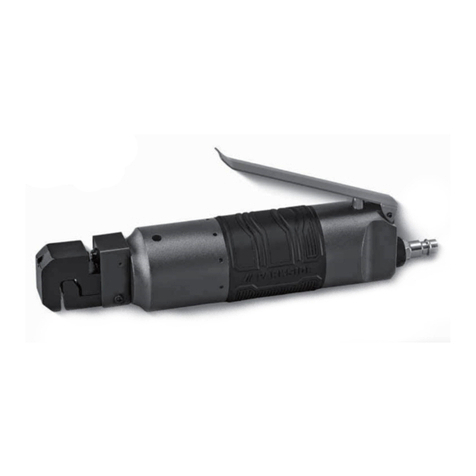
Parkside
Parkside 339156 1910 Translation of the original instructions
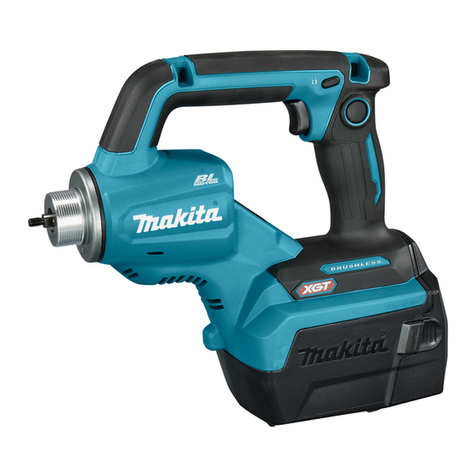
Makita
Makita VR001G instruction manual
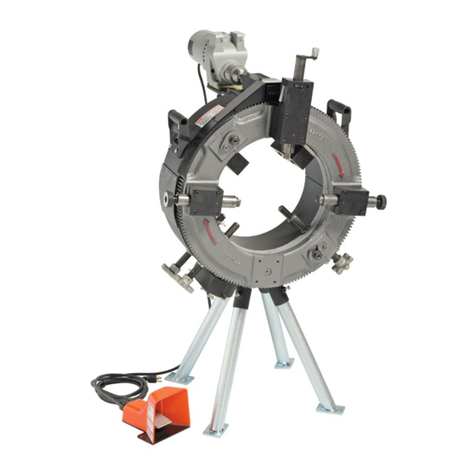
Victaulic
Victaulic VG412 Operating and maintenance instruction manual
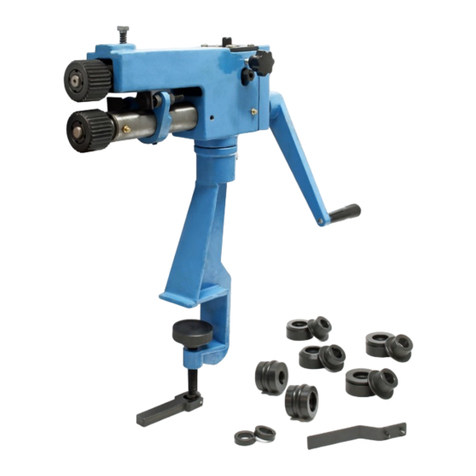
WilTec
WilTec 62053 Operation manual

Haussmann Xpert
Haussmann Xpert PNT116 Operator's manual

Shindaiwa
Shindaiwa M242S Owner's/operator's manual
